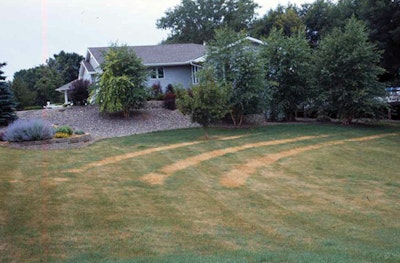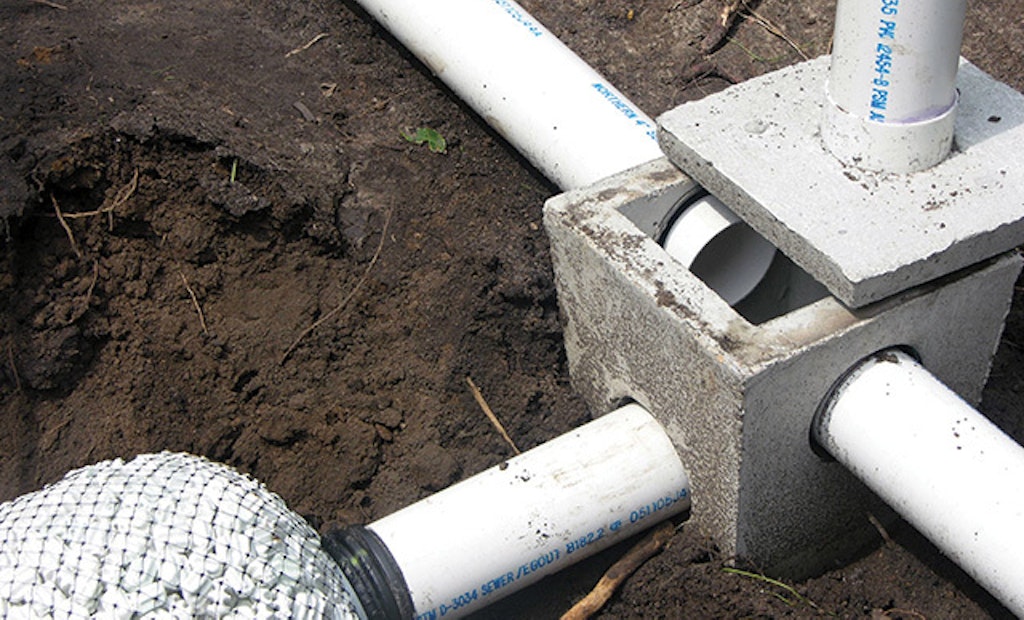Interested in Distribution?
Get Distribution articles, news and videos right in your inbox! Sign up now.
Distribution + Get AlertsOne topic that has generated numerous questions over the years is the distribution of effluent by gravity in an onsite treatment system.
The question has come up again in the context of inspections for real estate transactions and for inspections by service providers to determine how to take care of systems into the future. The specific question this time is: If I evaluate trenches and I find effluent is ponded in them, should I be worried? The answer actually goes back to the initial installation and how effluent is supposed to move through the system.
Three components
We like to break gravity distribution into three pieces. The first is the gravity sewer pipe from the house to the septic tank; the second is the outlet pipe from the septic tank to the soil treatment unit; and the third is between parts of the soil treatment unit (in most cases this means a series of trenches).
For the first piece where the pipe will carry both liquid and solids from the house to the septic tank, the piping needs to be laid with a slope of 1/8 to 1/4 inch per 8 feet. This ensures that both the liquid and the solids pass along the pipe to the tank. In between water uses in the house, there should be nothing but air in this pipe. If there is, something is wrong with the way the piping was laid out. We also always suggest, and many codes now require, that a clean-out be provided for this pipe so that the piping can be accessed from the outside.
The piping from the septic tank to the soil treatment unit should also run empty between water uses. The slope here is not critical because the pipe is not expected to carry solids, only effluent. Nevertheless, the piping needs to be laid with a slope and without any dips where effluent could collect and freeze.
Critical question
Now to the real core of the question: How does effluent get distributed between parts of the soil treatment unit? There are three recognized types of gravity distribution between trenches: parallel, sequential and serial. While some differences in these methods are subtle, they have a large impact on how the system operates.
Parallel distribution
The design theory for gravity parallel distribution is that the effluent moves through the piping from the septic tank into the highest elevation within a distribution box, which then has multiple outlets established at the same elevation within the box. Piping from these outlets supplies effluent to each of the trenches. The theory is that with each outlet at the same elevation, once the box fills up to the outlets, equal amounts of effluent move out to each trench.
In reality, this almost never happens! People often highlight for us that they set boxes up on a level site and run water in, and some water goes into more than one outlet pipe. But when we explore further the answer is: "Well, no, it's not exactly equal and more does go out one pipe." Our response is: "If it's not equal, it's not equal."
This idea of equal distribution has also led to an assumption that all trenches need to be of equal lengths. This flies in the face of natural soil variability, which says that even if exactly the same amount of effluent went to each trench, the trenches will not accept exactly the same amount of water.
These points and others have now led some to recommend that parallel distribution be used only on level or nearly level sites. There can still be
significant problems with this arrangement as well, and we will probably discuss them in future articles.
In practice, what often happens in the parallel trench arrangement is that the installer, through the use of pipe caps and holes or leveler products, makes sure the effluent actually moves through the trenches in a sequential fashion. Now, the trench at the highest elevation receives the effluent first, then the second, and so forth. This leaves effluent in some of the piping that may be subject to freezing.
Sequential distribution
In sequential distribution, effluent is loaded directly into the first trench and then, as the biomat forms, the trench gradually fills up to a predetermined level. Effluent then passes on to the next trench in the sequence. This is best done using drop boxes instead of a distribution box.
A drop box has the inlet elevation in the box at least 1 inch above the invert of the outlet pipe to the next box in sequence. Then, at the bottom of the box, there are outlets to convey effluent to the trenches.
The piping between the boxes serving the trenches should have at least a 1-inch drop in 8 feet to make sure the pipe runs empty between water uses, leaving no effluent at risk of freezing. Here, the second trench in sequence does not see any effluent until the biomat is fully developed in the first trench and liquid has ponded within that trench to the level of the outlet.
Serial distribution
Serial distribution looks somewhat similar, but with some important distinctions that explain why many jurisdictions do not allow it. All of the effluent passes through the first trench before being conveyed either with drop boxes or some other type of relief device to the other trenches. Here the flow pattern is serpentine, so there is no easy way to manage the system.
The bottom line
So, in answer to the question about effluent in the trenches being a problem: First we need to know how the effluent is to move in the system. If in sequential distribution the first trench is full, the second in sequence has some effluent, and the third is dry, the system is operating exactly as it should, so the ponding is not a problem.
On the other hand, if there is effluent ponded to the top of the first two trenches and effluent is nearly ponded to the distribution pipe in the third trench, this system is operating near capacity, and there may be surfacing problems in the near future.
We hope this description has helped. Since we have been talking about these issues since we started, we are sure there will be more distribution questions in the future.








